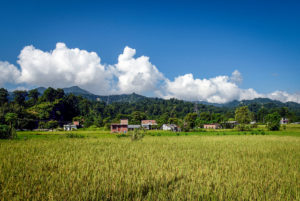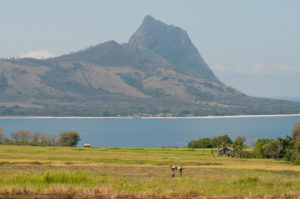
In Bhutan, a small Buddhist kingdom in the Himalayas, it is often the middle road that is chosen. A new paper, part of the CGIAR Research Program on Forests, Trees and Agroforestry (FTA), looks at the connections between forests and Gross National Happiness in the country.
There’s the middle path of the country’s religion and its emphasis on spiritual balance, symbolized in the prayer flags and pagoda tops that peek through the mountain trees. Then there’s the Lateral Road, the main highway that runs east to west through the middle of the country, where Robin Sears, Center for International Forestry Research (CIFOR) consultant and an Assistant Professor at Hampshire College, rides her bike when she visits the area to research forests, villages and governance.
A middle-road approach also applies to the country’s self-designed development index: Gross National Happiness (GNH), conceptualized by the fourth king in the 1970s as a more holistic replacement for the standard measure of Gross Domestic Product (GDP).
Enshrined in Bhutan’s Constitution in 2008, the GNH index now serves as a yardstick for every piece of legislature introduced in the country, ensuring a balance of its four pillars of environmental conservation, cultural preservation, equitable socioeconomic development and good governance.
“It’s so wonderful that GNH looks at a balance of socioeconomic and environmental issues,” says Sears. “It’s structured into policymaking processes. Every proposal for development and budgets and policy has to go through the GNH Commission to see if it meets balanced requirements. It mixes people from different sectors together.”
Often, the pillars of GNH work like dominoes falling into one another. A community’s good relationship with the environment leads to the preservation of their culture, which moves governance to help support the environment through proper forest ecosystem practices. Environment-based socioeconomic development then occurs, and so on.

Until now, however, very little research has been done on these chain reactions, and specifically the relationship between GNH and forestry. Along with a team of five other scientists, Sears recently published a paper looking at existing literature on GNH and assessing how forests tie into this framework.
“I’d been going to Bhutan since 2009, and I’d always heard from my colleagues that we didn’t have evidence for this or that,” says Sears. “So I was sitting with some of them talking over dinner one night, and we realized that we first needed to define what we needed evidence for, what were the most critical issues in forest ecosystem services in Bhutan. And so we said, ‘Let’s do this thing!’”
Read more: Forest ecosystem services and the pillars of Bhutan’s Gross National Happiness
SETTING THE TARGETS
The researchers set out to define a baseline for how forests are linked to the country’s developmental direction.
“Everything we do has to feed into government plans,” says Sears. “You can’t come here to study butterflies because you love butterflies. We have to come and do stuff that Bhutan needs.”
The nation’s needs are outlined in the government’s Five Year Plans, which set targets and budgets across all major sectors for the coming period. The current plan, covering the period 2013-2018, includes four priority areas related to forest ecosystem services, the most important of which is enhancing water security through a national water resource management plan.
“The big thing that the government has been pushing in the last four to eight years is watershed management. How do we reduce soil erosion? How do we keep rivers clean?”
But there is little research as yet on water issues, such as quality, quantity, watersheds and the effects of hydropower infrastructure. For instance, Bhutan’s dams face issues of flooding and adverse effects on biodiversity, like fish, algae, flora and rare fauna like white-bellied herons.
Furthermore, as water supplies change with shifting precipitation patterns and the melting of Himalayan glaciers due to climate change, studies on water regulation and payment mechanisms for water protection are set to become increasingly important. The new study lays out what knowledge exists on these topics so that the gaps can be filled in.
Another priority for this five-year period is strengthening livelihood opportunities for forest-based communities – in other words, increasing the incomes of those who depend on forests. If this is successful, forestry authorities can use the success stories to push harder for the maintenance of forests in the face of competing interests for development of land into ranches or cash-crop plantations.
“As well as boosting the productivity of forests, we want to create and promote a market for forest products. If we can show that standing forests are valuable, that’s the way to keep them around,” says Sears.
Read more: How are China, Nepal and Ethiopia restoring forest landscapes?
SAVING THE SACRED
For centuries, Bhutanese communities have closed access to mountains on a rotating basis, believing that this keeps them in the good favor of local deities. This practice, known as Reedum, coincides with the warmer seasons, which are most conducive for forest growth, in turn promoting forest preservation and preventing natural disaster. Another tradition, Tsadum, restricts grazing on certain landscapes in a similar way.
“Such practices are important to enhance a wide range of regulating, cultural and supporting services, although the provisioning services may be limited due to the restricted use,” says CIFOR scientist Himlal Baral, a coauthor of the paper.
Whether a lack of landslides and flash floods are considered a result of the gods’ good graces or of scientifically sound practices, the fact is that Reedum, Tsadum and other sacred customs have long been effective forest and landscape management techniques. However, they have no formal place in law, and therefore are becoming endangered.
Sonam Phuntsho, another coauthor of the paper, and a senior researcher at the Ugyen Wangchuck Institute for Conservation and Environmental Research, says there is a lack of data on how much forest in Bhutan is managed under customary law, or how many sacred groves still exist. Social changes are also impacting their survival, he adds.
“There are ongoing threats to sacred groves and associated ecosystem services due to changing social dynamics and economic development,” he says.
Sears agrees. “In the last 20 years, policy has shifted, and customary norms and rules have been banned or ignored and replaced by scientific forestry,” she says. “Cultural preservation, which includes spiritual rules and beliefs, is going to be forgotten if people cannot practice.”
Sears and her fellow scientists hope their research leads to the gathering of evidence on the effectiveness of traditional land management practices to share with the government, ultimately seeing these social norms incorporated into policies.
One reason awareness of such practices has disappeared from government offices is the increased urbanization of Bhutanese communities, leading to an erosion of culture and, ultimately, landscapes.

For the past two decades, tree cover has increased by 0.2 percent annually, but not always for good reason. Sears explains that migration is dually caused by factors of push and pull. First, threats posed by wildlife – elephants eating crops and knocking down houses, bears eating livestock, wild boars digging up fields – result in a huge loss of income that pushes people off of their farms. At the same time, the allures of better education and easier work pulls people into the capital Thimphu or other developed areas.
As villages empty of their workers, farmland is increasingly unattended, allowing forests to close in on homesteads, bringing more threats of wildlife and forest fires.
“Food security is a big problem for the government,” says Sears. “Who will grow food? There’s a big push in the next five-year plan to get people back to the farm by modernizing farming, introducing new technologies and greenhouses. The government also wants to go all-organic by 2020 and make rural life more viable with increased phone coverage, better schools and roads.”
THE HAPPINESS CONNECTION
The domino effect theorized by Sears and colleagues – with cultural preservation leading to good governance, which drives environmental conservation, and in turn leads to equitable socioeconomic development – was strongly supported by their review of the literature. This backs the idea that forests and their ecosystem services contribute to the four pillars of GNH, supporting Bhutan’s happiness-based development goals.
Although finding empirical evidence of the direct links between forests and GNH was challenging, “the strongest connection in this regard was found in relation to the pillars of good governance and socioeconomic development, particularly through community-based forestry schemes,” says Baral.
As communities act to restore mountainous forest landscapes, boosting essential ecosystem services and protecting from risks of disaster, more research is needed to determine the effects on national development, as defined by the happiness index.
Judging from the research results so far, it could well be a middle path worth taking.
By Gabrielle Lipton, originally published at CIFOR’s Forests News.
For more information on this topic, please contact Himlal Baral at h.baral@cgiar.org or Robin Sears at r.sears@cgiar.org.
This research forms part of the CGIAR Research Program on Forests, Trees and Agroforestry, which is supported by CGIAR Fund Donors.
This research was supported by the Republic of Austria.











